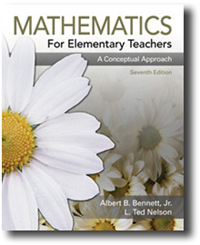 MATH 230. Fundamental Concepts II
MATH 230. Fundamental Concepts II
![]()

View the course
abstract.
View the
course
syllabus for Fall 2009.
Read the message "To the
Student."
View the instructor's
policies.
View the "Guidelines
for Written Work."
View the "MATH
230 Course Objectives."
View the
assignments
and test schedule for this course.
View the
tentative
class schedule with notes for some class sessions.
View a Grade
Calculation Worksheet.
View Don Cathcart's home page.
View some links
for this course.
![]()
This is a freshman level course designed to provide prospective elementary school teachers with some of the skills, concepts, problem solving abilities, and appreciations necessary to function and an effective teacher of elementary school mathematics. The course addresses the following topics: Problem Solving; Using Spreadsheets (Excel) in Problem Solving (optional); Informal Geometry and Measurement; Percents, Ratios and Proportions; Functions and Mathematical Models; Mathematical Reasoning.
The course focuses on six primary themes: (1) problem solving and mathematical modeling; (2) development of number systems through the real numbers; (3) characteristics and properties of geometric shapes; (4) understanding, representing, manipulating, and applying percents, and ratios and proportions; (5) understanding, representing, and applying functions; and (6) mathematical communication. Students are engaged in problem solving tasks throughout the course, and they are encouraged to use problem solving strategies utilizing spreadsheets, and calculators where appropriate. Problem settings and properties of the numbers and operations are used to motivate the extension of our "number universe" from rational numbers to real numbers. A "concrete-to-abstract continuum" is employed in associating meanings with numbers, relations, and operations. Written assignments are designed to cause students to reflect on their learning process and to become adept in using mathematical terminology in oral and written communication.
The method of instruction in this course employs a constructivist, activity-based, approach. Students frequently use calculators or computers. Accordingly, students are encouraged to use those tools while working actively together, and on their own, in assuming responsibility for their own learning and in communicating their mastery of the course objectives.